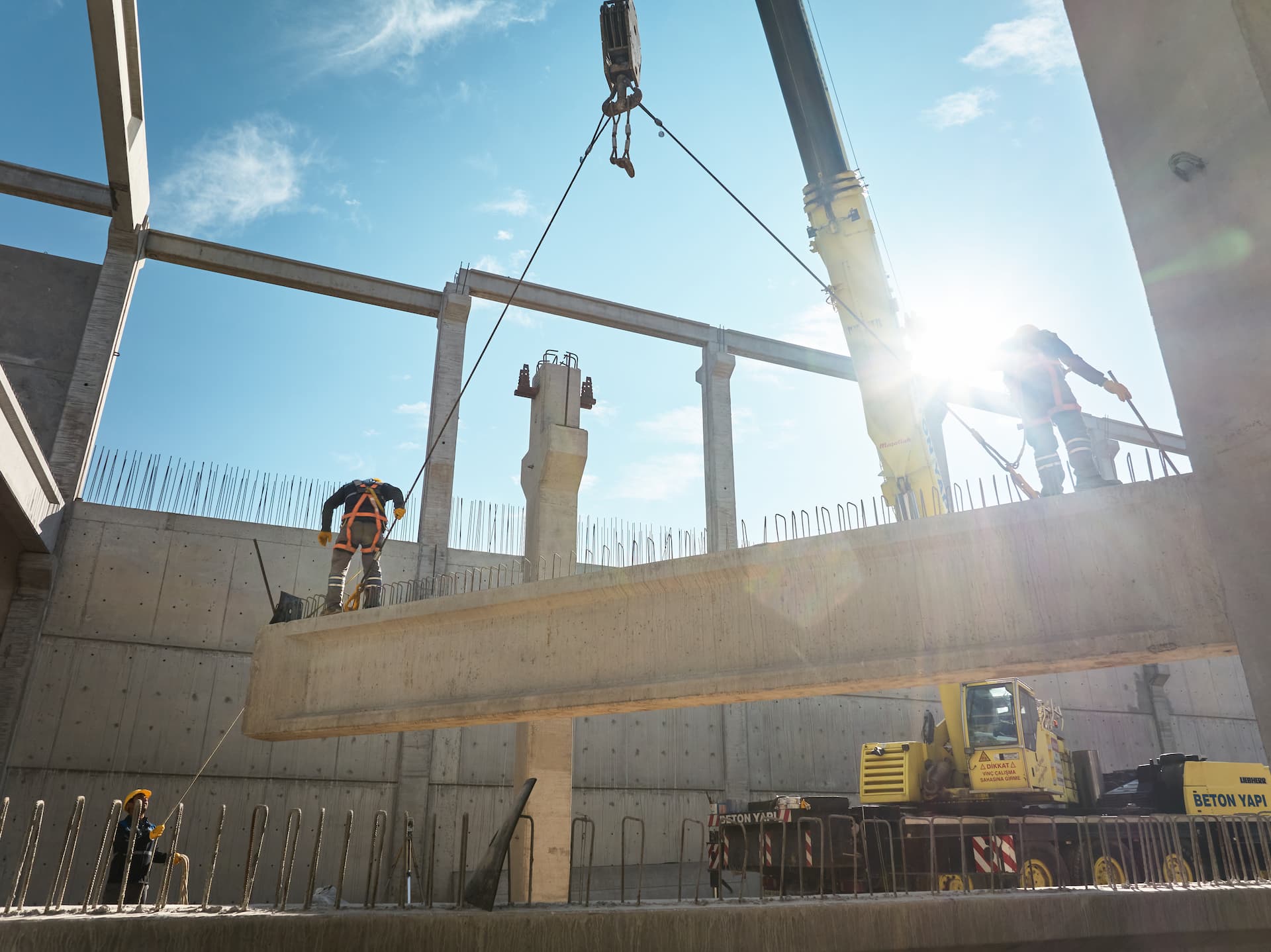- COMPANY
- BUILDING ELEMENTS
- SERVICES
- PRODUCTS
- REFERENCES
- BLOG
- CONTACT
- COMPANY
- BUILDING ELEMENTS
- SERVICES
- PRODUCTS
- REFERENCES
- BLOG
- CONTACT

Differences Between Prefabricated Buildings and Modular Construction
04.06.2025The construction industry is evolving rapidly with increasing demand for fast, cost-effective, and safe building solutions. Among these solutions, prefabricated buildings and modular construction are two prominent approaches. But what exactly sets them apart? Let’s explore the differences and see which one fits your needs best.
Definition and Structural Differences
Prefabricated buildings are constructed by manufacturing structural elements such as beams, columns, and panels in a factory environment, then assembling them on-site.
Modular construction involves building larger sections or nearly complete rooms off-site, which are then transported and assembled as whole modules.
Installation and Portability
- Prefabricated structures are typically fixed and permanent once installed.
- Modular buildings offer better portability and can be relocated with minimal effort.
Design Flexibility
Prefabricated buildings provide strength and aesthetics similar to traditional concrete structures, ideal for factories, warehouses, and offices. Modular buildings, on the other hand, are well-suited for residential, temporary, or mobile applications.
Applications
Prefabricated: Industrial facilities, office complexes, social spaces
Modular: Emergency shelters, construction site units, schools, mobile offices
Cost and Time Considerations
Both systems can save up to 50% of the time compared to traditional construction. Prefabricated buildings are more economical long-term due to their durability and stability. Modular buildings may offer a lower initial investment, especially when speed and flexibility are key.
Make the Right Choice with Beton Yapı
As a leading company based in Kahramanmaraş, Beton Yapı helps you select the most suitable system. We offer production and on-site assembly services for both prefabricated buildings and custom modular solutions.
Prefabricated and modular construction methods both provide strong alternatives to traditional building. Your decision should be based on your intended use, budget, and timeline.
- Sundurmalı Prefabrik Depo Modellerinde Doğru Kapı Yerleşimi Nasıl Olmalı? 01.12.2025
- Sundurmalı Yapılarda Lojistik Akış Neden Daha Verimlidir? 29.11.2025
- Sundurmalı Prefabrik Sanayi Yapılarında Yükleme Boşaltma Hızı Nasıl Artırılır? 27.11.2025
- Kreynli Prefabrik Fabrikalarda Operasyon Verimliliği Nasıl Artar? 25.11.2025
- Kreynli Yapılarda Taşıyıcı Sistem Güçlendirmesi Nasıl Planlanır? 21.11.2025
- Kreynli Prefabrik Sanayi Yapılarında Doğru Kreyn Kapasitesi Nasıl Seçilir? 18.11.2025
- Panel Duvarlı Prefabrik Yapıların Üretim Süreci Nasıl İşler? 14.11.2025
- Panel Duvarlı Sanayi Yapılarında Yangın Dayanımı Ne Düzeydedir? 11.11.2025
- Panel Duvarlı Prefabrik Yapılarda Yalıtım Kalitesi Nasıl Belirlenir? 07.11.2025
- Tek Eğimli Çatılı Prefabrik Depolarda Verimli Hava Akışı Nasıl Sağlanır? 03.11.2025
- Tek Eğimli Çatılı Sanayi Yapılarında Doğru Eğim Oranı Nasıl Hesaplanır? 30.10.2025
- Tek Eğimli Çatılı Prefabrik Yapılarda Su Yalıtımı Ve Isı Performansı 24.10.2025
- Çok Katlı Sanayi Projelerinde Maliyet Optimizasyonu Nasıl Yapılır? 21.10.2025
- Çok Katlı Prefabrik Yapılarla Yüksek Kapasiteli Fabrikalar Nasıl Kurulur 17.10.2025
- Çok Katlı Prefabrik Sanayi Yapılarında Güvenlik Nasıl Sağlanır? 14.10.2025
- Ara Katlı Yapılarda Taşıyıcı Sistem Seçimi Nasıl Yapılır? 10.10.2025
- Ara Katlı Prefabrik Yapı Kullanımının Depolama Ve Üretime Etkisi 07.10.2025
- Ara Katlı Prefabrik Sanayi Yapılarında Alan Verimliliği Nasıl Artırılır? 03.10.2025
- Tek Katlı Betonarme Prefabrik Yapılarda Dayanım Performansı Nasıl Ölçülür? 29.09.2025
- Tek Katlı Prefabrik Yapılarda Hızlı Montaj ile Üretim Avantajı Nasıl Sağlanır? 26.09.2025
- Tek Katlı Prefabrik Sanayi Yapılarında En Doğru Tasarım Nasıl Belirlenir? 22.09.2025
- Prefabrik Fabrika Yapılarında Yangın Güvenliği Nasıl Sağlanır 19.09.2025
- Prefabrik Fabrika Kurulumunda Lojistik Süreç Nasıl Yönetilir 16.09.2025
- Fabrika Yapımı İçin Doğru Zemin Etüdü Nasıl Yapılır 12.09.2025
- Gaziantepte Prefabrik Yatırımlar İçin Uygun Arsa Nasıl Seçilir 08.09.2025
- Boşluklu Döşeme ile Geniş Açıklıklı Yapılar Nasıl İnşa Edilir? 05.09.2025
- Prefabrik Yapı Elemanları ile Hızlı Üretim Kapasitesi Nasıl Oluşturulur 01.09.2025
- Prefabrik Fabrika Projelerinde Enerji Verimliliği Nasıl Sağlanır 29.08.2025
- Prefabrik Depo Yapılarında Raf Sistemine Göre Tasarım Nasıl Belirlenir 26.08.2025
- Prefabrik Sanayi Yapılarında Akıllı Yerleşim Planı Nasıl Oluşturulur 22.08.2025
- Prefabrik Yapı ile Uzun Ömürlü Sanayi Tesisleri Oluşturma 18.08.2025
- Prefabrik Fabrika İnşaatı Sürecinde Dikkat Edilmesi Gereken Teknik Detaylar 15.08.2025
- Prefabrik Fabrika Yapımı ile Hızlı Ve Güçlü Üretim Tesisleri Oluşturma 12.08.2025
- Fabrika Yapımı Sürecinde Karşılaşılan Zorluklar Ve Çözüm Önerileri 08.08.2025
- Gaziantep’te Fabrika Yapımı İçin Yatırımcılara Rehber Niteliğinde Bilgiler 05.08.2025
- Boşluklu Döşeme Kullanılan Yapılarda Dayanım Ve Performans Değerlendirmesi 01.08.2025
- Prefabrik Yapı Elemanlarının Üretimde Sağladığı Teknik Avantajlar 28.07.2025
- Prefabrik Fabrika Kurmak İsteyenler için Kapsamlı Yol Haritası 25.07.2025
- Prefabrik Depo Projelerinde Doğru Planlama Nasıl Yapılır? 22.07.2025
- Prefabrik Sanayi Yapıları ile Üretim Alanlarında Verim Artışı 18.07.2025
- Prefabrik Yapı ile Yatırım Sürecini Hızlandırmanın Yolları 14.07.2025
- Is It Worth Building a Prefabricated Warehouse in Kahramanmaraş? 10.07.2025
- The Safest Structure for Earthquake Zones: Precast Concrete Buildings 08.07.2025
- Why Prefabricated Factories Are Preferred in Industrial Zones 06.07.2025
- What Are the Architectural Advantages of Using Precast Concrete Panels? 04.07.2025
- A Guide for Those Planning a Prefabricated Building Investment in Gaziantep 02.07.2025
- Government Incentives and KOSGEB Supports for Prefabricated Buildings 28.06.2025
- Legal Aspects of Using Prefabricated Buildings on Agricultural Land 26.06.2025
- The Importance of Engineering and Structural Calculations in Prefabricated Projects 24.06.2025
- Expansion Strategy with Prefabricated Structures in Industrial Investments 22.06.2025
- How Is Cold Air Insulation Achieved in Prefabricated Warehouses? 20.06.2025
- Looking Ahead to 2030: How Is the Future of Prefabricated Buildings Shaping Up? 18.06.2025
- How Are Prefabricated Concrete Panels Manufactured? 16.06.2025
- Economic Impact of Rapid Installation in Prefabricated Buildings 14.06.2025
- Advantages of Investing in Prefabricated Structures in Gaziantep Organized Industrial Zone 12.06.2025
- What Are the Cost Components of Prefabricated Factory Projects? 10.06.2025
- Logistics Planning and Transportation Efficiency in Prefabricated Buildings 08.06.2025
- How to Build Smart Production Areas in Prefabricated Factories? 06.06.2025
- Differences Between Prefabricated Buildings and Modular Construction 04.06.2025
- How to Ensure Speed and Safety in Urban Transformation with Prefabricated Buildings? 02.06.2025
- Suitable Prefabricated Building Models for Industrial Zones in Gaziantep 30.05.2025
- Permit Process and Preparation for Prefabricated Factory Projects 29.05.2025
- Prefabricated Solutions Guide for Warehouse Construction 28.05.2025
- Shorten Your Investment Payback Period with Prefabricated Buildings 27.05.2025
- Thermal and Acoustic Insulation in Prefabricated Industrial Buildings 26.05.2025
- Beton Yapı’s Leading Prefab Projects in Gaziantep 23.05.2025
- Launch Your Production Area Fast with Prefabricated Buildings 22.05.2025
- Key Considerations for Prefab Investments in Gaziantep and Surroundings 20.05.2025
- Prefabricated Warehouse or Steel Construction? Decision Guide 19.05.2025
- Rising Demand for Prefabricated Factories in Gaziantep 16.05.2025
- How to Choose the Right Foundation and Structural System in Prefabricated Buildings 15.05.2025
- Expand Your Production Area with Prefabricated Industrial Buildings 14.05.2025
- Prefabricated Warehouses: Fast Setup, Long Lifespan 13.05.2025
- 2025 Guide to Prefabricated Buildings in Gaziantep 12.05.2025
- Why Are Prefabricated Buildings an Advantage for Industrial Investments? 09.05.2025
- Modern Life in the Countryside: A Fresh Start with Prefabricated Buildings 08.05.2025
- Prefabricated Building Solutions for the Agriculture and Livestock Industry 07.05.2025
- How Effective Is Insulation in Prefabricated Structures? 06.05.2025
- Build Your Dream Structure in Weeks with BetonYapı 05.05.2025
- Create Long-Lasting Living Spaces with Prefabricated Concrete Structures 02.05.2025
- Prefab Building Trends and Expectations for 2025 30.04.2025
- Sustainability in the Construction Industry: What Prefabrication Offers 29.04.2025
- Turnkey Prefabricated Projects with Beton Yapı 28.04.2025
- How Does the Assembly Process of Prefabricated Structures Work? 25.04.2025
- Get Inspired by BetonYapı's Reference Projects 24.04.2025
- Earthquake-Resistant Structures: The Strength of Prefabricated Concrete 23.04.2025
- Architectural Flexibility in Prefabricated Structures: Design It Your Way 22.04.2025
- Turn Your Dream of a Detached Home into Reality with Prefabricated Structures 21.04.2025
- Support the Economy with Locally Produced Prefabricated Structures 18.04.2025
- Why Is Fire Resistance of Prefabricated Concrete So Important? 17.04.2025
- Hangi Alanlarda Prefabrik Yapılar Daha Uygun? 16.04.2025
- Build Modern Workspaces with Prefabricated Office Structures 15.04.2025
- Time and Cost Savings in Prefabricated Factory Construction 14.04.2025
- Prefabricated Factory Installation Time: How Fast Is It 10.02.2025
- Advantages of Prefabricated Factories: Lower Cost, Higher Efficiency 27.01.2025
- Improve Your Business with Factory Building Projects 06.01.2025
- Things to Consider When Choosing Prefabricated Construction Companies 17.02.2025
- Why Should Prefabricated Solutions Be Preferred for Industrial Buildings? 07.04.2025
- How Are Prefabricated Building Prices Determined? 10.03.2025
- Prefabricated Building Models: Modern and Functional Designs 13.01.2025
- Prefabricated Warehouse Construction Processes and Advantages 20.01.2025
- Prefabricated Industrial Buildings: Fast and Economical Solutions 03.03.2025
- Everything You Need to Know About Prefabricated Factory Construction 03.02.2025
- Why are Prefabricated Buildings Environmentally Friendly? 17.03.2025
- Energy Efficiency and Sustainability of Prefabricated Buildings 31.03.2025
- Prefabricated Offices and Commercial Buildings: Fast Solution, High Efficiency 24.02.2025
- What are Prefabricated Buildings and What are Their Advantages Over Traditional Construction? 24.03.2025
1. Km No: 7/C Türkoğlu
Kahramanmaraş
Türkiye


